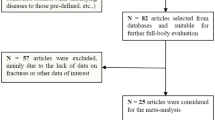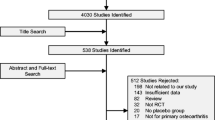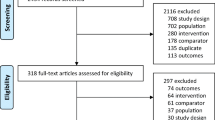Abstract
Most osteoporosis treatments have proven efficacy in reducing the risk of vertebral fractures, whereas evidence is less straightforward for prevention of non-vertebral fractures. Conclusions as to the efficacy of a treatment should be based primarily on analyses of the intention to treat (ITT) population rather than on exploratory subgroup analyses; however, non-vertebral anti-fracture efficacy has been largely derived by post-hoc subgroup analyses. This review and meta-analysis was performed to assess non-vertebral anti-fracture efficacy of several osteoporosis therapies, including a more stringent assessment of the ITT populations. Data on non-vertebral anti-fracture efficacy, a defined endpoint of the ITT analyses and confirmed by radiographs, were obtained from randomized, placebo-controlled, phase III clinical trials of at least 3-year duration. Meta-analyses were performed for the two bisphosphonates, alendronate and risedronate. Relative risks (RR), 95% confidence intervals (CI) and statistical significance for active treatment compared with placebo were calculated. Eleven clinical trials met the criteria for review, three of which showed statistically significant ( P ≤0.05) non-vertebral anti-fracture efficacy in the ITT population: two trials with risedronate and one trial with strontium. A meta-analysis showed significant reductions in the relative risk of non-vertebral fracture for both alendronate (RR=0.86; 95% CI: 0.76–0.97, P =0.012) and risedronate (RR=0.81; 95% CI: 0.71–0.92, P =0.001). Risedronate and strontium ranelate were the only treatments to show non-vertebral anti-fracture efficacy in this robust assessment of anti-fracture efficacy of osteoporosis therapy using ITT populations in trials of 3 years or more in duration. Risedronate was the only agent shown to demonstrate efficacy in more than one trial. Meta-analysis showed that both alendronate and risedronate provide non-vertebral anti-fracture efficacy.


Similar content being viewed by others
References
Consensus development conference (1993) Consensus development conference: diagnosis, prophylaxis, and treatment of osteoporosis. Am J Med 94:646–650
Chrischilles EA, Butler CD, Davis CS, et al (1991) A model of lifetime osteoporosis impact. Arch Intern Med 151:2026–2032
Liberman UA, Weiss SR, Broll J, et al (1995) Effect of oral alendronate on bone mineral density and the incidence of fractures in postmenopausal osteoporosis. The Alendronate Phase III Osteoporosis Treatment Study Group. N Engl J Med 333:1437–1443
Black DM, Cummings SR, Karpf DB, et al (1996) Randomised trial of effect of alendronate on risk of fracture in women with existing vertebral fractures. Fracture Intervention Trial Research Group. Lancet 348:1535–1541
Cummings SR, Black DM, Thompson DE, et al (1998) Effect of alendronate on risk of fracture in women with low bone density but without vertebral fractures: results from the Fracture Intervention Trial. JAMA 280:2077–2082
Harris ST, Watts NB, Genant HK, et al (1999) Effects of risedronate treatment on vertebral and nonvertebral fractures in women with postmenopausal osteoporosis: a randomized controlled trial. Vertebral Efficacy With Risedronate Therapy (VERT) Study Group. JAMA 282:1344–1352
Reginster J, Minne HW, Sorensen OH, et al (2000) Randomized trial of the effects of risedronate on vertebral fractures in women with established postmenopausal osteoporosis. Vertebral Efficacy with Risedronate Therapy (VERT) Study Group. Osteoporos Int 11:83–91
McClung MR, Geusens P, Miller PD, et al (2001) Effect of risedronate on the risk of hip fracture in elderly women. Hip Intervention Program Study Group. N Engl J Med 344:333–340
Meunier PJ, Roux C, Seeman E, et al (2004) The effects of strontium ranelate on the risk of vertebral fracture in women with postmenopausal osteoporosis. N Engl J Med 350:459–468
Reginster JY, Seeman E, DE Vernejoul MC, et al (2005) Strontium ranelate reduces the risk of nonvertebral fractures in post-menopausal women with osteoporosis: Tropos Study. J Clin Endocrinol Metab DOI 10.1210/jc.2004–1774 (website checked 22 April 2005)
Chesnut CH 3rd, Silverman S, Andriano K, et al (2000) A randomized trial of nasal spray salmon calcitonin in postmenopausal women with established osteoporosis: the prevent recurrence of osteoporotic fractures study. PROOF Study Group. Am J Med 109:267–276
Recker R, Stakkestad J, Weber T, et al (2002) Nonvertebral fracture benefit from oral ibandronate administered daily or with a unique drug-free interval: Results from a pivotal phase III study in postmenopausal osteoporosis (PMO). J Bone Miner Res 17 [Suppl 1]:S35
Chesnut CH, Skag A, Christiansen C, et al (2004) Effects of oral ibandronate administered daily or intermittently on fracture risk in postmenopausal osteoporosis. J Bone Miner Res 19:1241–1249
Ettinger B, Black DM, Mitlak BH, et al (1999) Reduction of vertebral fracture risk in postmenopausal women with osteoporosis treated with raloxifene: results from a 3-year randomized clinical trial. Multiple Outcomes of Raloxifene Evaluation (MORE) Investigators. JAMA 282:637–645
Committee for Proprietary Medicinal Products (2001) Note for guidance on postmenopausal osteoporosis in women. Committee for Proprietary Medicinal Products (CPMP), London
FDA (1994) Guidelines for preclinical and clinical evaluation of agents used in the prevention or treatment of postmenopausal osteoporosis. US Food and Drug Administration
European Agency for the Evaluation of Medicinal Products (1998) ICH Topic E9. Note for guidance on statistical principles for clinical trials. The European Agency for the Evaluation of Medicinal Products
CPMP (2001) Points to consider on application with 1. Meta-analyses; 2. One pivotal study. Committee for Proprietary Medicinal Products (CPMP), London
Whitehead AS (2002) Meta-analysis of controlled clinical trials. Wiley & Sons, Chichester
Cranney A, Tugwell P, Adachi J, et al (2002) Meta-analyses of therapies for postmenopausal osteoporosis. III. Meta-analysis of risedronate for the treatment of postmenopausal osteoporosis. Endocr Rev 23:517–523
Cranney A, Tugwell P, Wells G, et al (2002) Meta-analyses of therapies for postmenopausal osteoporosis. I. Systematic reviews of randomized trials in osteoporosis: introduction and methodology. Endocr Rev 23:496–507
Cranney A, Tugwell P, Zytaruk N, et al (2002) Meta-analyses of therapies for postmenopausal osteoporosis. IV. Meta-analysis of raloxifene for the prevention and treatment of postmenopausal osteoporosis. Endocr Rev 23:524–528
Cranney A, Tugwell P, Zytaruk N, et al (2002) Meta-analyses of therapies for postmenopausal osteoporosis. VI. Meta-analysis of calcitonin for the treatment of postmenopausal osteoporosis. Endocr Rev 23:540–551
Cranney A, Wells G, Willan A, et al (2002) Meta-analyses of therapies for postmenopausal osteoporosis. II. Meta-analysis of alendronate for the treatment of postmenopausal women. Endocr Rev 23:508–516
Papadimitropoulos E, Wells G, Shea B, et al (2002) Meta-analyses of therapies for postmenopausal osteoporosis. VIII: Meta-analysis of the efficacy of vitamin D treatment in preventing osteoporosis in postmenopausal women. Endocr Rev 23:560–569
Shea B, Wells G, Cranney A, et al (2002) Meta-analyses of therapies for postmenopausal osteoporosis. VII. Meta-analysis of calcium supplementation for the prevention of postmenopausal osteoporosis. Endocr Rev 23:552–559
Wells G, Tugwell P, Shea B, et al (2002) Meta-analyses of therapies for postmenopausal osteoporosis. V. Meta-analysis of the efficacy of hormone replacement therapy in treating and preventing osteoporosis in postmenopausal women. Endocr Rev 23:529–539
Wehren LE, Hosking D and Hochberg MC (2004) Putting evidence-based medicine into clinical practice: comparing anti-resorptive agents for the treatment of osteoporosis. Curr Med Res Opin 20:525–531
Karpf DB, Shapiro DR, Seeman E, et al (1997) Prevention of nonvertebral fractures by alendronate. A meta-analysis. Alendronate Osteoporosis Treatment Study Groups. JAMA 277:1159–1164
Boonen S, Haentjens P, Vandenput L, et al (2004) Preventing osteoporotic fractures with antiresorptive therapy: implications of microarchitectural changes. J Intern Med 255:1–12
Watts NB, Cooper C, Lindsay R, et al (2004) Relationship between changes in bone mineral density and vertebral fracture risk associated with risedronate: greater increases in bone mineral density do not relate to greater decreases in fracture risk. J Clin Densitom 7:255–261
Neer RM, Arnaud CD, Zanchetta JR, et al. (2001) Effect of parathyroid hormone (1–34) on fractures and bone mineral density in postmenopausal women with osteoporosis. N Engl J Med 344:1434–1441
Pols HA, Felsenberg D, Hanley DA, et al (1999) Multinational, placebo-controlled, randomized trial of the effects of alendronate on bone density and fracture risk in postmenopausal women with low bone mass: results of the FOSIT study. Foxamax International Trial Study Group. Osteoporos Int 9:461–468
Farrerons J, Isaia G, Renau A, et al (2003) Effects of raloxifene on vertebral and nonvertebral fractures in postmenopausal women with osteoporosis with multiple (greater than or equal to 2) prevalent vertebral fractures. ECTS:P-230
Wright CC, Sim J (2003) Intention-to-treat approach to data from randomized controlled trials: a sensitivity analysis. J Clin Epidemiol 56:833–842
Hollis S, Campbell F (1999) What is meant by intention to treat analysis? Survey of published randomised controlled trials. Brit Med J 319:670–674
Phillips A, Haudiquet V (2003) ICH E9 guideline ‘Statistical principles for clinical trials’: a case study. Stat Med 22:1–11; discussion 13–17
Colman EG (2003) The Food and Drug Administration’s Osteoporosis Guidance Document: past, present, and future. J Bone Miner Res 18:1125–1128
Acknowledgements
Dr. S. Boonen is senior clinical investigator of the Fund for Scientific Research, Flanders, Belgium (F.W.O., Vlaanderen) and holder of the Leuven University Chair for Metabolic Bone Diseases. This study was supported by grant G.0171.03 N from the Fund for Scientific Research, Flanders, Belgium (F.W.O., Vlaanderen). The authors thank Christine Gilchrist for performing the Medline, EMBASE and BIOL electronic literature searches.
Author information
Authors and Affiliations
Corresponding author
Rights and permissions
About this article
Cite this article
Boonen, S., Laan, R.F., Barton, I.P. et al. Effect of osteoporosis treatments on risk of non-vertebral fractures: review and meta-analysis of intention-to-treat studies. Osteoporos Int 16, 1291–1298 (2005). https://doi.org/10.1007/s00198-005-1945-x
Received:
Accepted:
Published:
Issue Date:
DOI: https://doi.org/10.1007/s00198-005-1945-x




